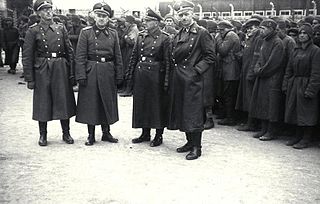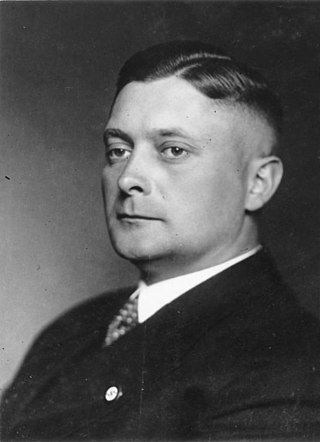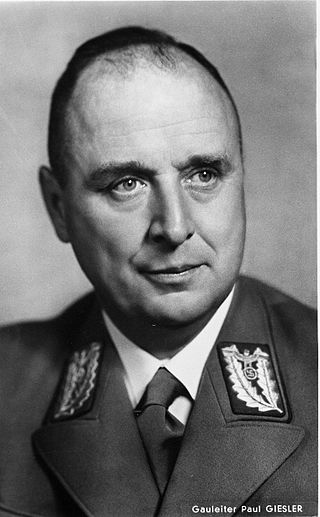
Josef Antonius Heinrich Terboven was a Nazi Party official and politician who was the long-serving Gauleiter of Gau Essen and the Reichskommissar for Norway during the German occupation.

Theodor Eicke was a senior SS functionary and Waffen SS divisional commander during the Nazi era. He was one of the key figures in the development of Nazi concentration camps. Eicke served as the second commandant of the Dachau concentration camp from June 1933 to July 1934, and together with his adjutant Michael Lippert, was one of the executioners of SA Chief Ernst Röhm during the Night of the Long Knives purge of 1934. He continued to expand and develop the concentration camp system as the first Concentration Camps Inspector.

Arthur Karl Greiser was a Nazi German politician, SS-Obergruppenführer, Gauleiter and Reichsstatthalter of the German-occupied territory of Wartheland. He was one of the persons primarily responsible for organizing the Holocaust in occupied Poland and numerous other crimes against humanity. He was arrested by the Americans in 1945, and was tried, convicted and executed by hanging in Poland in 1946 for his crimes, most notably genocide.

Gerhard Friedrich Ernst Flesch was a German SS functionary during the Nazi era. After World War II, he was tried, found guilty and executed for his crimes, specifically the torture and murder of members of the Norwegian resistance movement.

Gertrud Emma Scholtz-Klink, néeTreusch, later known as Maria Stuckebrock, was a Nazi Party member and leader of the National Socialist Women's League (NS-Frauenschaft) in Nazi Germany.

Kurt Max Franz Daluege was a German SS and police official who served as chief of Ordnungspolizei of Nazi Germany from 1936 to 1943, as well as the Deputy/Acting Protector of Bohemia and Moravia from 1942 to 1943.

Karl August Hanke was an official of the Nazi Party (NSDAP) during its rule over Germany and served as the fifth and final Reichsführer of the Schutzstaffel (SS). He also served as Gauleiter of Gau Lower Silesia from 1941 to 1945 and as Oberpräsident of the Prussian Province of Lower Silesia. Captured on 6 May 1945, he was shot and wounded during an escape attempt and then beaten to death by Czech communists on 8 June, after the war had ended.

SS-Totenkopfverbände was the Schutzstaffel (SS) organization responsible for administering the Nazi concentration camps and extermination camps for Nazi Germany, among similar duties. While the Totenkopf was the universal cap badge of the SS, the SS-TV also wore this insignia on the right collar tab to distinguish itself from other SS formations.

Karl Kaufmann was a German politician who served as a Nazi Party Gauleiter from 1925 to 1945 and as the Reichsstatthalter of Hamburg from 1933 to 1945.

Udo Gustav Wilhelm Egon von Woyrsch was a Nazi Party politician and SS-Obergruppenführer in Nazi Germany who participated in the massacre of Jews in Poland, and was later convicted of being an accessory to manslaughter in connection with the Night of the Long Knives murders.

Gustav Adolf Scheel was a German physician and Nazi Party official. He served as a "multifunctionary" in Nazi Germany, including posts as the Reich Student Leader leading both the National Socialist German Students' League and the German Student Union, as an SS member and Sicherheitsdienst employee, as a Higher SS and Police Leader, as well as Gauleiter and Reichsstatthalter in Reichsgau Salzburg. He was also an Einsatzgruppe commander in occupied Alsace and he organized the October 1940 deportation of Karlsruhe's Jews to extermination camps.

Paul Giesler was a German Nazi Party functionary responsible for acts of brutality which included killing opponents of the regime in southern Germany. He first joined the Nazi Party (NSDAP) in 1922; he reenrolled on 1 January 1928 with Party number 72,741. From 1941 he was Gauleiter of Westphalia-South (Westfalen-Süd) and in 1942 was appointed to the position for the Gau Munich-Upper Bavaria. From 2 November 1942 to 28 April 1945 he was also Minister-President (Ministerpräsident) of Bavaria.

Hugo Jury was an Austrian Nazi. He held the offices of Gauleiter of Reichsgau Niederdonau and Reichsstatthalter for Lower Austria. He committed suicide at the end of the World War II.

Josef Wagner was from 1931 the Nazi Gauleiter of Gau Westphalia-South and, as of December 1934, also of Gau Silesia. In 1941 he was dismissed from his offices, then expelled from the Nazi Party (NSDAP), imprisoned by the Gestapo, and likely executed around the time of end of the war in Europe.
Adolf Johann Albert Hoffmann was a German entrepreneur, who during the Third Reich served as the Nazi Gauleiter of Westphalia-South. He was also an SS-Gruppenführer. Tried for war crimes, he was acquitted for lack of evidence, but was sentenced to prison as a result of denazification proceedings.

Rudolf Querner was a German SS functionary during the Nazi era. He served as the Higher SS and Police Leader in Austria and Germany and was responsible for the evacuations and death marches from concentration camps at the end of the war. Arrested by the Allied authorities, he committed suicide in prison.

Ernst-Heinrich Schmauser was a German Nazi Reichstag deputy and SS-Obergruppenführer who was the Higher SS and Police Leader (HSSPF) in Breslau during World War II. He was responsible for the death march from Auschwitz-Birkenau concentration camp, in which upwards of 25 percent of the prisoners were killed. In the last months of the war, he was captured by the Red Army and presumed killed.
Ernst Klink was a German military historian who specialised in Nazi Germany and World War II. He was a long-term employee at the Military History Research Office (MGFA). As a contributor to the seminal work Germany and the Second World War from MGFA, Klink was the first to identify the independent planning by the German Army High Command for Operation Barbarossa.
Fritz Schlessmann, born Georg Friedrich Schlessmann was a Nazi Deputy Gauleiter of Gau Essen and served as Acting Gauleiter for most of the Second World War. He was also a prominent police official and SS-Obergruppenführer.
















